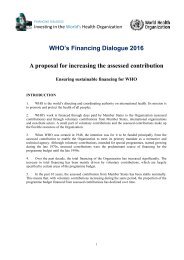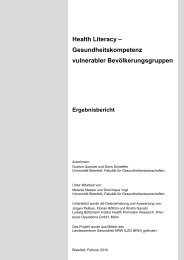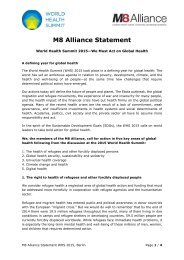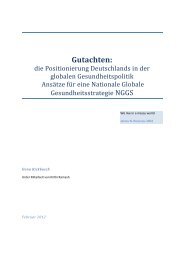POLIO PLANNING
TransitionGuidelinesForPolioLegacy
TransitionGuidelinesForPolioLegacy
You also want an ePaper? Increase the reach of your titles
YUMPU automatically turns print PDFs into web optimized ePapers that Google loves.
needed to support significant decision-points, while informal communication (e.g., discussion at<br />
ad hoc meetings, emails to stakeholders) may be appropriate for routine process updates.<br />
RISK ASSESSMENT & MITIGATION<br />
Large, complex transitions may have multiple risks associated with execution. The execution plan should<br />
clearly identify the most salient potential risks and proactively develop mitigation plans to ensure the<br />
transition remains on track. For example, upcoming transitions in key government leaders may<br />
significantly disrupt the execution process. Addressing this risk may require an advocacy plan,<br />
development of interim oversight measures, etc. Other potential risks to consider include: staff turnover;<br />
political and leadership changes; delays in policy development or funding availability; etc.<br />
MONITORING AND ACCOUNTABILITY FRAMEWORK<br />
A monitoring and accountability framework will not only allow effective tracking of transition<br />
implementation over time, but will ensure that all stakeholders hold a shared vision of the transition<br />
outcomes, timeline and milestones.<br />
• Outcome objectives. The M&E framework should define a final outcome or a set of relevant<br />
outcomes for the execution plan: what assets are concerned, where they are transitioned to, and<br />
for what purpose. Each outcome should be associated with a timeline.<br />
• Monitoring indicators. Establishing monitoring indicators for each outcome can be a way to track<br />
ongoing progress against execution goals and milestones. Monitoring indicators must be SMART:<br />
specific, measurable, achievable, relevant and time-bound. Indicators used to monitor the<br />
execution phase of the transition should not only track progress of implementation, but should<br />
monitor the ongoing quality of activities conducted during implementation so that gaps can be<br />
identified and addressed. Examples of indicators are shown in the template, below. A source for<br />
collecting and verifying indicator data should be specified, along with a baseline value, where<br />
relevant.<br />
• Timeline/milestones. For each outcome, interim milestones should be defined to track progress<br />
against the outcome over time. If there are a large volume of assets to transfer, transition can be<br />
done gradually. Milestones mark interim goals and can range from key meetings where decisions<br />
are made to finalization of communication strategies. While shorter timelines may be appropriate<br />
in certain circumstances, particularly where transition is relatively straightforward, the<br />
integration of assets is generally a long process. Insufficient timelines may in assets not being fully<br />
or effectively integrated. Further, gradual processes have been identified as a success factor of<br />
transition. Examples of actionable milestones are shown in the template, below.<br />
Figure 1. Sample Monitoring & Accountability Framework<br />
Transition plan<br />
outcome<br />
objectives<br />
Outcome<br />
indicators<br />
Data source<br />
Baseline<br />
If applicable<br />
Milestones<br />
The timeframe for monitoring progress against<br />
indicators may be quarterly, annually, or<br />
continuously, and may vary by outcome<br />
objective.<br />
Year 1 Year 2 Year 3 Year 4<br />
xiii









